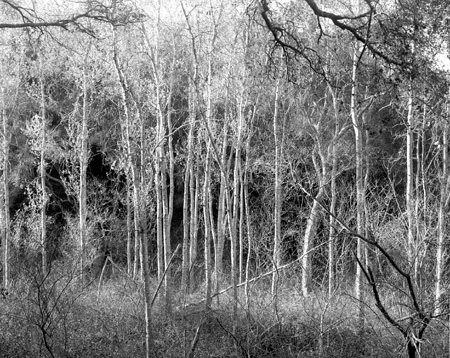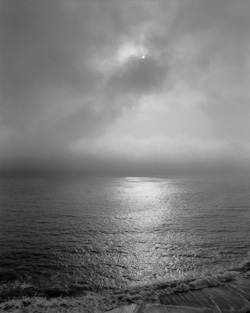Spot Meters
The Ultimate Tool For The Thinking Photographer? Page 2
 |
|
|
First we make a reading of the darkest
area in which we wish to capture some texture. The dark weathered wood a little
way inside the bridge should work. There will be some areas that are darker,
but that's all right, as we're interested in an area that we want
to record with full texture.
Reflected meters are calibrated to make what they read a medium tone in the
image. Many texts refer to this tone as 18 percent gray or middle gray. There
is some controversy about the actual standard used, but suffice it to say that
if you think of this tone as middle gray you'll be fine. In the Zone System
this medium tone is referred to as Zone V (Zone 0 being pure black and Zone
X being pure white). But Zone V, the equivalent to an 18 percent gray card,
is too light for the shadow area we just read, so what do we do? Well, stopping
the lens down one f/stop will make the shadow darker, or a Zone IV tonality,
and stopping down an additional f/stop will place it on Zone III.
 |
|
|
OK, I have now set or placed my exposure to achieve Zone III, the darkest zone with full texture, for the shadow area I selected. So now what? Well, I next read the lightest area that I want to record with some texture, perhaps the white clapboard, and if the meter indicates that it is on or below Zone VIII the scene will record with full texture. Light meters with zone scales or Zone System modes (more on that later) will save a little bit of finger and toe counting here. Now the Zone System is a bit more involved than my brief discourse but not all that much, really. The point is you can really see how much useful information a spot meter can give you in this scene, and in similar scenarios.
 |
|
|
Check The Chart
So, maybe you're starting to think that a spot meter might fit into your
photographic toolkit. Well, if so, what should you be looking for feature-wise
and how much should you budget? To help answer these, and a lot of other questions
you'll come up with, I've included a chart that lists the current
choices in spot meters, and some multipurpose meters that have spot capabilities.
Some of these meters read ambient light only, while the multipurpose meters
offer spot and/or incident capabilities for ambient and flash photography, a
valuable feature if you do any studio photography. A few years ago I started
using a multipurpose meter and I have found it very convenient to have one meter
that fulfills all my metering needs. Some meters have special Zone System modes
that greatly simplify the implementation of the Zone System and for at least
one, the Pentax Digital Spot Meter, you can purchase a Zone System scale that
gives you a visual representation of the zones and their relationship to one
another.
Whether you are shooting with a digital camera or still prefer film, a spot
meter can give you the edge in controlling exposure, help you to achieve more
mastery of your medium, and improve your technique, allowing you to create more
expressive photographs. A worthwhile investment, don't you think?
- Log in or register to post comments

































